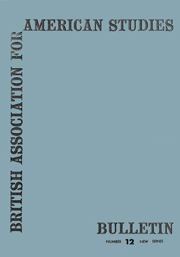Article contents
The Pathfinder: Leatherstocking in Love
Published online by Cambridge University Press: 17 February 2011
Extract
The Pathfinder (1840) is the only Leatherstocking tale in which Natty Bumppo at all resembles the wavering hero of a Scott novel. Here for the first and only time we see him waver between the life he has always led — untrammelled by property, responsible only to his own strict code and conscience, free to follow his own bent away from white European society — and the life of a border family man with all that that implies in terms of a wife who must be kept content with her lot, children.who must be properly educated, property which must be acquired and protected. Yet The Pathfinder is not in the least like a Waverley novel. It is not even very much like one of the earlier Leatherstocking tales. Why, more than a decade after burying Leatherstocking in The Prairie (1827), did Cooper revive him again? And why revive him in this particular way?
- Type
- Research Article
- Information
- Copyright
- Copyright © British Association for American Studies 1965
References
- 2
- Cited by


